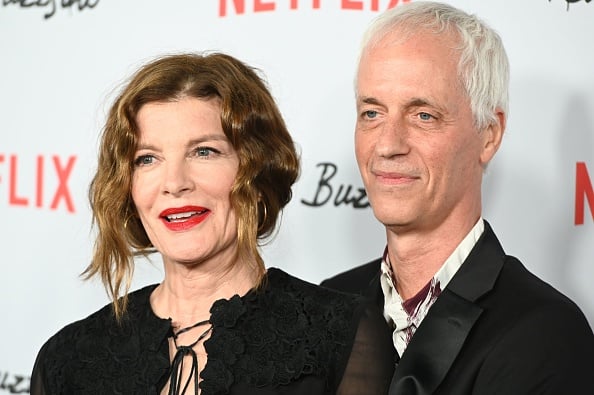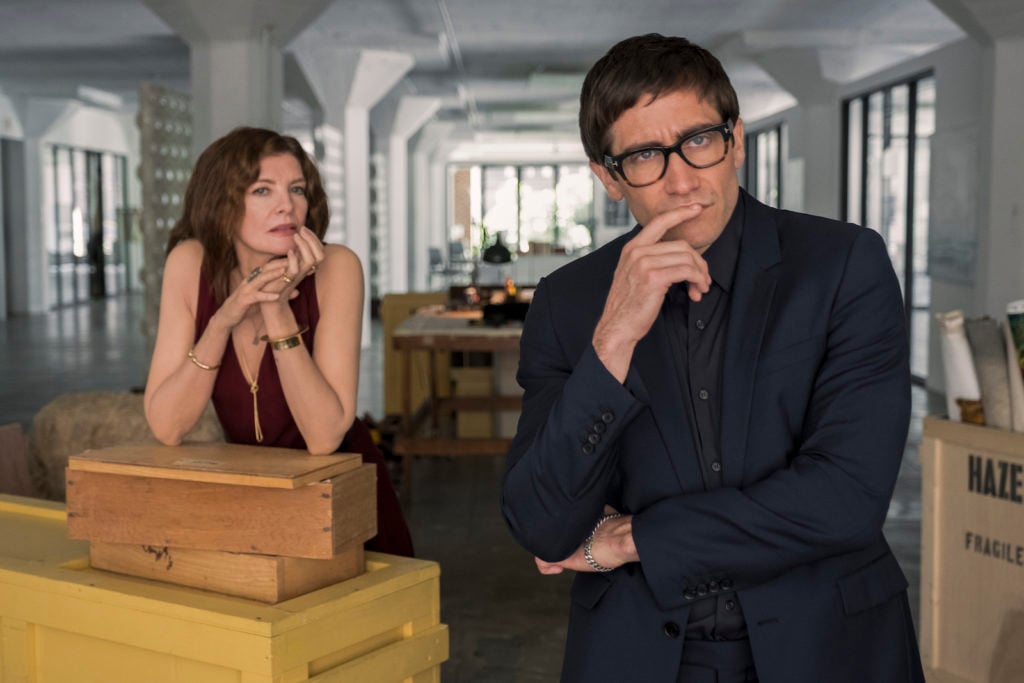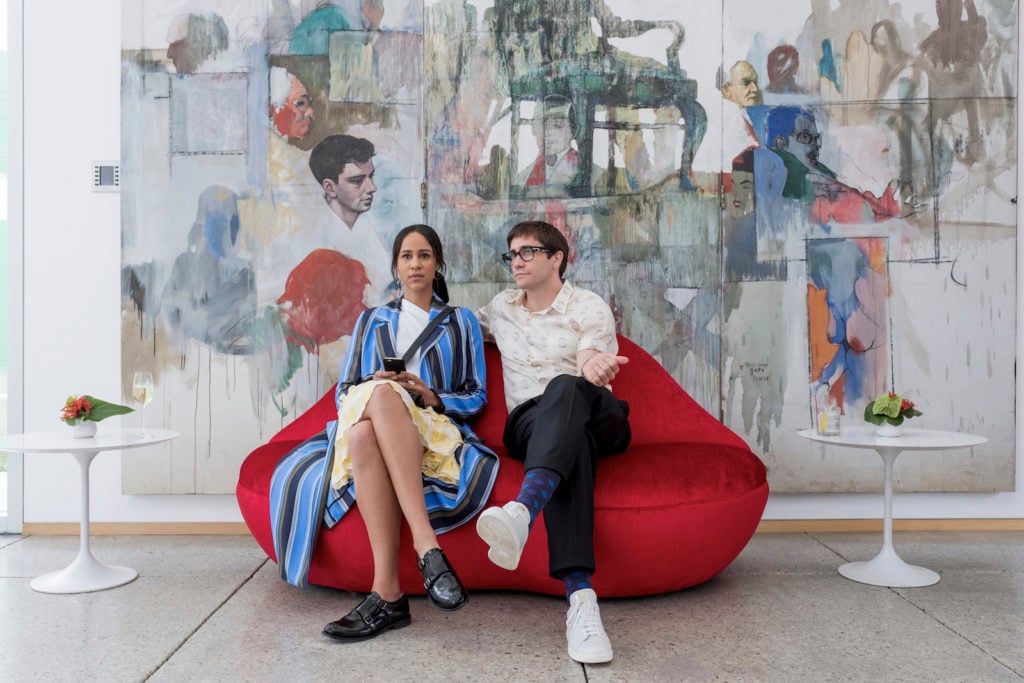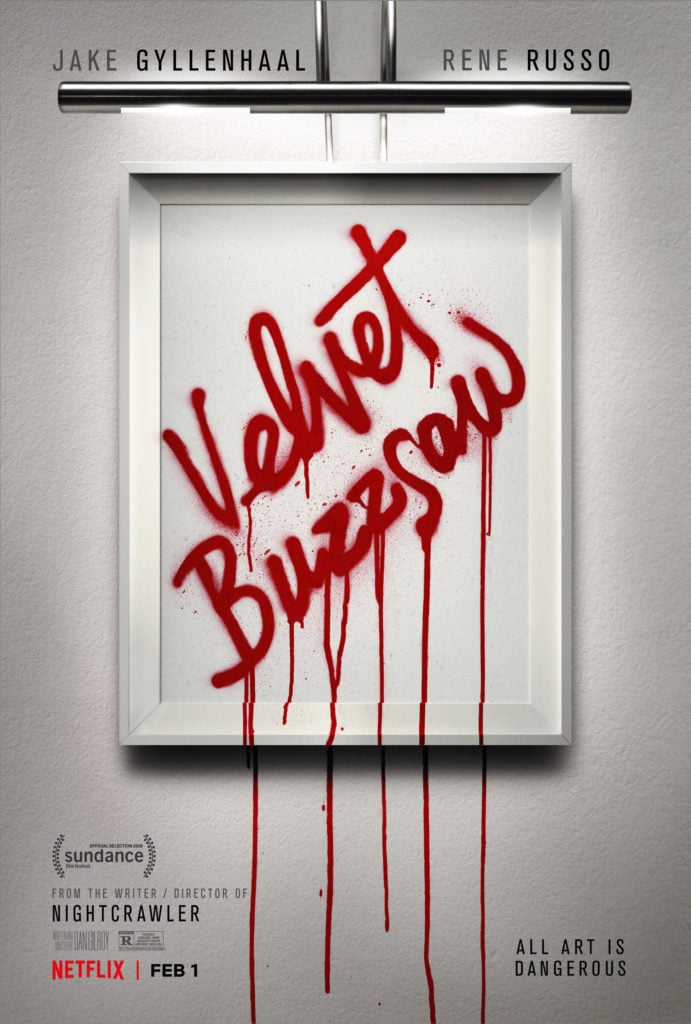People
‘I Will Always Be Interested in What Money Does to People’: ‘Velvet Buzzsaw’ Director Dan Gilroy on the True Value of Art
Plus, the filmmaker explains why there should be a Netflix for the art world.

Plus, the filmmaker explains why there should be a Netflix for the art world.

Tim Schneider

No matter what your opinion is of Velvet Buzzsaw, Netflix’s horror-satire of the big-money contemporary art market, there is no denying that the movie tore its way right to the top of the art world conversation when it was released on February 1.
The film stars Jake Gyllenhaal as an ethically conflicted critic “ensorcelled” by the work of a mysterious self-taught artist whose paintings become the prize—and, it turns out, the fatal bait—for a viper’s nest of gallerists, advisers, and assorted accomplices whose crassness is their own undoing.
To dissect the motivations, themes, and wider relevance of the film, writer-director Dan Gilroy chopped it up with artnet News’s own art business reporter (and film industry expatriate) Tim Schneider by phone on the day of its release.
You’ve talked about how the seed of Velvet Buzzsaw was planted by a visit to an unsettling show at Dia:Beacon, but obviously there’s a huge amount of work in between that and developing a fully realized world on screen. Could you talk about the research and development behind the movie?
What I’m doing [in my films] these days is going into what you might call niche worlds. I want any film that I do to have as much realism as possible. I’m injecting themes and ideas that are relevant to me, but if people in that world who are watching it don’t feel it’s real, then I think I’ve missed the mark.
The research was months and months of research online, talking to gallery owners, and going to galleries. My primary art adviser is a gentleman named David Hundley, who has been deeply embedded in the contemporary art world all of his life. We brought in two more art advisers during production to come to the set and oversee the layout of things, to go through the lexicon. So we made every effort possible to make it realistic. Last week I finally caught up with the documentary The Price of Everything, and I was heartened that people who I never had access to [were] openly addressing issues that I thought were very accurately reflected in our film.
The central theme of Velvet Buzzsaw and The Price of Everything is the effect of big money on art. At what point did you get interested in this idea as opposed to just the visual intrigue of the art world?
One of the things that has relevance to me, because it’s happening in the film industry, is the domination of branded [intellectual property], of trends, of repetitive productions that fall into a canon. I was interested in exploring the uneasy relationship between art and commerce in all arenas of entertainment in today’s world. I feel strongly that the quality of a work shouldn’t be judged by the volume of social media engagement, or the number of people who went and saw it the first weekend, or the amount paid at Sotheby’s. It’s not to say that commercial success diminishes a work. It doesn’t. But it doesn’t define a work, either.

Rene Russo and Jake Gyllenhaal in Velvet Buzzsaw. Image courtesy Netflix.
Continuing with that parallel, Velvet Buzzsaw is the type of mid-size movie that wouldn’t get a huge release today, since it’s not based on pre-existing intellectual property and isn’t aiming to be a blockbuster franchise. By making the movie with Netflix, you’ve given it a much wider reach than if you’d made it with a smaller traditional studio. How important is that idea to you?
There were [traditional] studios that wanted to make this film, but no studios that were willing to step up and give us the money we felt we needed below the line. [Note: “Below-the-line” budgets cover production and crew, but not actors, writers, directors, or producers.] Netflix was more than willing to give us everything we needed, financially, artistically, and in every way, to make the film that we wanted to make.
But a couple of years ago, I had no experience with Netflix whatsoever. I’m an older person who really only knew the theatrical experience. The first thing I found online was an article written by somebody saying, “Netflix is a nefarious organization because they’re going to destroy the theatrical experience.” But 50 comments followed [saying] basically the [opposite] thing: “You must live in New York or Los Angeles. You must have access to all the films that come out, because I live in a place where I don’t have access to [those] things.”
That was really eye-opening to me as a storyteller, and I suddenly felt very comfortable going with Netflix because I want the stories to be seen. They don’t have to be loved. They can be hated. That’s not really relevant to me. I want the story to be disseminated, because to me these ideas that you and I were just talking about are important. And here is this platform that has democratized the storytelling experience so that everybody around the world has a chance to see this [movie].
Netflix fills a void in the marketplace by giving opportunities to filmmakers who don’t want to make $250 million blockbusters or shoestring-budget indies. The art world is looking for that but hasn’t really figured out an answer yet.
I think the art world needs some version of Netflix. I don’t know what that would be. Maybe Netflix will branch into the world of contemporary art and revolutionize it. That would be great.

Zawe Ashton and Jake Gyllenhaal in Velvet Buzzsaw. Image courtesy Netflix.
Over the course of the past few years especially, there has been a lot of interest in the art world from Hollywood, where you have UTA launching a fine art division, Endeavor buying a stake in Frieze, and a set of contemporary artists trying to branch into directing feature films. What’s your perspective on that as somebody on the film side who obviously cares about art?
There’s a line in the film where Tom Sturridge, as the second biggest [gallerist] in Los Angeles, is trying to poach John Malkovich’s character from the biggest gallery. And he says to him, “In an attention economy, celebrity is an art form.” We live in an attention economy, where celebrity has its own value, where a known person or a known quantity, in and of themselves, becomes a brand. And that brand has a platform that allows that person to explore as many arenas of entertainment as they want. And it’s never going away.
I have no problem with it. People should try as many things as they can, and if somebody in the contemporary art world wants to come into the film business, I welcome them to come in. Julian Schnabel is a phenomenal filmmaker, in my mind.
I read something recently saying that the generational difference between people in earlier eras was that they wanted to become famous for doing a particular thing, and now they just want to become famous, then figure out how to parlay fame into a particular thing afterward.
Isn’t that such an interesting point? It’s like you get the platform that used to have to be earned. It’s a creative crossroads for a lot of people. Do I want to go into music? Do I want to go into fashion? The more we talk about it, the more I like the synergy of these different arenas of creativity. I think it becomes a melting pot for success that probably generates some very interesting work.
There’s always been a degree of crossover between these different spaces. You had Jean-Michel Basquiat collaborating with Fab 5 Freddy in the 1980s….
I remember, I was there! It was wild.
I’m sure! Returning to the toxic influence of big prices, at what point does the money involved in the art market become too much? Because I’m pretty sure that you’re not simply saying art is too sacred to be bought and sold.
It’s funny, I have no problem if somebody makes a work of art and sells it for $500 million. I’m interested in the forces that drive those numbers. Many people are going in on a purely investment level. With the [prices] going around, if you are a renowned gallery with a small number of artists who are highly successful as brands, you’re going to have very limited wall space or desire to, one, show new artists—so they’re getting crowded out—and two, if you have established artists that suddenly decide they want to buck their canon and try something new, I don’t think you’re going to be as inclined as you might’ve had these numbers not been so high. The forces that are driving these numbers up are having an effect on the art being made and the voices that are allowed to be heard.

Poster for Velvet Buzzsaw. Image courtesy Netflix.
Were you caught off guard by how cut-throat and high stakes the art market has become?
I wasn’t caught off guard by it because I don’t think the contemporary art world has cornered the market on gray morality. I honestly think I could lift a rock on any industry or any place where there’s large sums of money, and you’re going to see people operating, let’s phrase it, against their better natures.
I think I will always be interested in what money does to people—not in a moral way, but in the need to acquire wealth and to compete with other people who are becoming increasingly wealthy around them. The vast majority of the world is not well off economically, but a small sliver of people control a staggering amount of money, and these people socialize. If one person goes into somebody’s house and they see something that was bought for $50 million, the next step is to buy something for $70 million.
What’s very interesting about the contemporary art world is how public, by virtue of the media, this is. Everything gets reported on in terms of prices. The beautiful thing about The Price of Everything was how [open] everybody was in discussing it. How can you not talk about it when the sums are just so staggering? If you’re an artist, you’re probably ripping your hair out, but some of the people on the commerce side, I think, are just looking at each other going, “Can you believe what’s happening? This is amazing.”
That brings us to the John Malkovich character in Velvet Buzzsaw: an artist who became a brand and now is almost secretly trying to do something very different that fulfills him. But he doesn’t really even know how to handle creating anymore.
I tip my hat to anybody who can create something and pay the rent. And I’ll take that to the extreme. If you can create a brand, and make tens, if not hundreds, of millions of dollars, I don’t see anything wrong with that. But I think there’s a danger that once you start repeating yourself, you have the potential to blunt your creativity. And I think if you blunt it too much, it’s difficult to come back.
Creativity plays with the endless realm of the new. That’s why, in the opening scene, when the gallery owner is trying to sell Jake on Hoboman, the animatronics figure, Jake just pronounces what, to him, is the most important thing: “Wolfson, Female Figure, four years ago. It’s an iteration, no courage.” I feel [the way] Jake’s character does. I am always looking for something that’s groundbreaking.
And again, I’m not trying to judge people who do brands. But John Malkovich’s character in my film is a guy whose primary focus and support seems to be coming from this factory of reproductions he’s making while upstairs his subconscious is utterly stuck. That’s the pitfall I see that one could fall into.

Hoboman, an animatronic work of art (Mark Steger) in Velvet Buzzsaw (2019). Image courtesy Netflix.
Right, and he still ends up being one of the few characters who makes it out alive.
Well, you’ll notice the artists make it out alive, because that’s the way I see things. I’m a little biased, though.
The first movie you directed, Nightcrawler, is also about an ambitious character in Los Angeles, Lou Bloom, who’s willing to cross any moral or ethical boundary to achieve his vision of success. I was wondering if you saw these two films as companion pieces.
I see the three films that I’ve done as cousins of each other, with the common denominator being the economics of life and what the economics of life do to individuals. In Nightcrawler, I was presenting my view that we live in a hyper-capitalist world that’s become the jungle, and in the jungle the weak get killed and the strong get stronger. I always hoped that people saw Nightcrawler as a cautionary tale that the Lou’s of the world are winning. And in Velvet Buzzsaw, I’m pointing to this increasingly uneasy relationship between art and commerce.
Rene [Russo]’s character [in Velvet Buzzsaw] is named Rhodora, because I’ve always loved an Emerson poem called “Rhodora.” A Rhodora is a flower, and in the poem Emerson comes upon this beautiful Rhodora in the middle of nowhere, and he starts asking himself who gets to appreciate this beauty out here alone. I’ve always remembered the great few lines that follow: “Rhodora! If the sages ask thee why this charm is wasted on the earth and sky, tell them, dear, that if eyes were made for seeing, then beauty is its own excuse for being.”
That’s what I’m trying to say to artists in Velvet Buzzsaw. The value of art is not its worldly value. Artists invest a part of their soul and their spirit in whatever they’re doing, and that has its own value.
‘Velvet Buzzsaw’ is streaming now on Netflix.